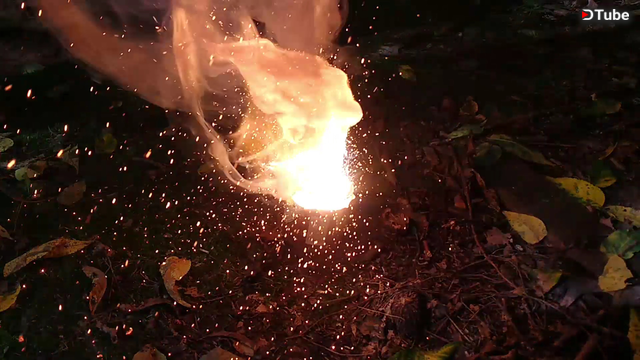
In this experiment I smelt iron ore using a modern aluminothermic reduction reaction (also known as thermite). Although this is the same kind of reaction as thermite, thermite uses man-made (or at least heavily processed) iron oxide while this reaction uses the natural impure ore as its iron oxide source. Performing this reaction both validates the smelting technique and also indicates that I am using high quality ore. The quality of the ore was something I was interested in because I can eliminate ore quality as one of the variables in the poor operation of my large smelting furnace. From a starting ore mass of about 36.5 grams, I recovered 11 grams of iron metal after breaking apart the slag bowl that had formed.
I performed this reaction by first gathering a few small pieces of iron ore that looked like they would be easy to crush. I then roasted them in a campfire twice where they were held at a nice cherry red heat for many hours. This step is important because it converts the iron sulfides, hydroxides, and other complex oxides into the simple iron oxides which are needed for the smelting reaction. Once roasted, the ore was then crushed to a powder and then mixed with aluminum powder and filings. This was then placed inside a small paper cup and an ignition charge was placed on top to kick-start the reaction.
The reaction is extremely exothermic and melts the resultant aluminum oxide and iron metal that formed in the reaction. In a future experiment, I will increase the the amount of reagents used as well as add some additional alloying metal oxides and carbon to give me a workable piece of steel from which I can make tools!
▶️ DTube
▶️ IPFS
Thank you for your contribution. Dont forget to link references and sources when applicable!
=======================================================================================
This post was upvoted and resteemed by @Steemgridcoin with the aim of promoting discussions surrounding Gridcoin and science.
This service is free. Please follow @steemgridcoin if you want to support this initiative.
Have a nice day. :)
Good to see you back here and great work.
I'm really fascinated to see other metals like Chromium, Molybdenum and Cobalt. Somewhere I saw the purity of the metal can benefit if you add a flux to the mixture as well as form the bottom of the cup with a high melting point refractory powder to help pool the metal.
Would love to try this out myself, but 1) too many other priorities 2) you can quickly get into trouble with the police here playing with thermite!
I am interested to see how other metal oxides will interact with the final product as well. I am also curious as to how hard it is going to be to control to carbon content in the final product by adding powdered carbon to the reagents.
This post has been voted on by the steemstem curation team and voting trail.
There is more to SteemSTEM than just writing posts, check here for some more tips on being a community member. You can also join our discord here to get to know the rest of the community!
Great post @hellfire-labs
Thermite is quite powerful. I saw on TV how rails were welded together using thermite. Also, when the reaction is started, it is impossible to stop the reaction with normal substances, due to the high temperatures and the fact that the reaction requires no external oxygen. I also saw a video where thermite was ignited above a glass tank filled with water. Short after falling in the water, there was a significant explosion
Quite impressive.
I'm sorry that I can't give you a valuable upvote for now. But this will definitely be done as soon as my VP has regenerated again on one of your comments. :-)
Thermite is quite an interesting substance! I was honestly quite surprised with the results of this test because there are quite a few impurities in the iron ore so I did not expect as high of a yield or as vigorous of a reaction. This looks promising for a future, larger smelt!
I'm already very excited about the follow-up :-)
Hotter, brighter, bigger :-D
This is just a test comment. Apologies @hellfire-labs